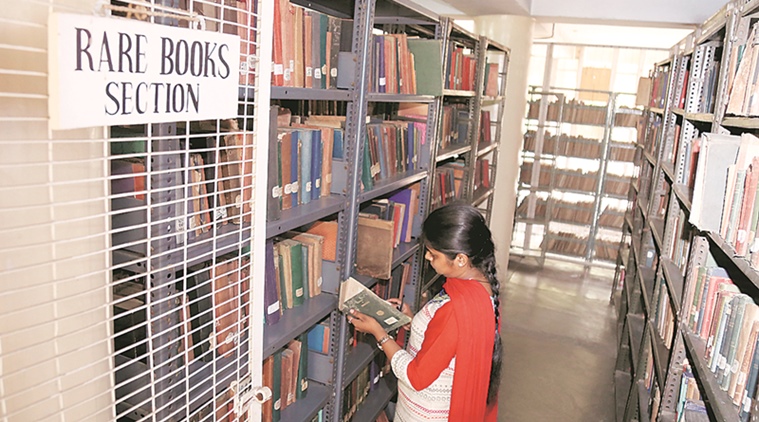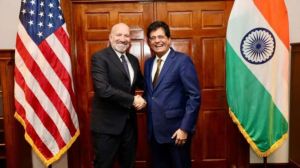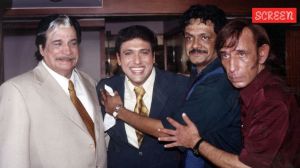Stay updated with the latest - Click here to follow us on Instagram
Dwarka Dass Library, Chandigarh: A date with history
At present, the library has around 85,252 books in English, Hindi, Punjabi and Urdu, with more than 2,000 members and an increase of as many as 60 members every month.
 Librarian Alka at the Rare Books section of Dwarka Dass Library at Lala Rajpat Rai Bhavan in Sector 15. (Express Photo by Sahil Walia)
Librarian Alka at the Rare Books section of Dwarka Dass Library at Lala Rajpat Rai Bhavan in Sector 15. (Express Photo by Sahil Walia)
TIME STANDS still in some sections of the Dwarka Dass Library, housed in Lajpat Rai Bhawan, Sector 15, Chandigarh. Nostalgia rules, as you walk down memory lane with 85-year-old Onkar Chand, the chairman of the Servants of the People Society (the Society founded by Lala Lajpat Rai). The library is the post-Partition restoration of its original in Lahore. It was established by Lala Laljpat Rai in memory of his friend Dwarka Dass, who donated his personal library to Servants of the People Society. After Partition, the library was shifted to Shimla and then to Chandigarh in 1962, where it was housed at Panjab University and was moved to Lajpat Rai Bhawan in Sector 15 in 1966, inaugurated on August 28, by M C Chagla, the then union education minister of India.
“Every fourth book here is a rare one. It is a repository of rare literature of the freedom movement and preserves in its collection the memorabilia of the struggle for the emancipation of the nation and its cultural heritage. This library was known as the Revolutionaries Shrine because Bhagat Singh and his colleagues made this library their sanctuary. It played a home to patriots and freedom fighters. It is a treasure trove of rare and out-of-print publications of political, educational and social history of India, especially of Punjab,” says Chand, who has been part of the Society and Library for more than 38 years now.
READ | Belying the all-round doom and gloom about falling book readership
At present, the library has around 85,252 books in English, Hindi, Punjabi and Urdu, with more than 2,000 members and an increase of as many as 60 members every month. As Alka Kashyap, the librarian, takes you through various sections and reading rooms of the library, you notice how every part of the library is thronged with students, research scholars, book lovers, who have been part of the space for years. The Rare Books Section is a big hit with research scholars from across the region, says Alka, as she takes you through the prized collection, including reference books, reports, manuscripts, bound periodicals, confidential documents of the British era, gazetteers, legislative assembly debates, besides ‘The People,’ a newspaper started by Lala Lajpat Rai and ‘Harijan Sewak’ edited by Mahatma Gandhi. The First Resolution of the Indian National Congress, 1885, is also a part of the library.
Reference books include dictionaries, encyclopedia, a 14-volume set of Imperial Gazetteer of India published in 1909 in 26 volumes, district gazetteers of United Punjab published during the British period and books on Indian war of Independence, 1857. Other than this there are books written by Lala Lajpat Rai and on Lala Lajpat Rai by various authors, besides books read by great patriots like Shaheed Bhagat Singh. To commemorate the memory of Bharat Ratna Rajrishi Purushottam Das Tandon, a children’s library was started in August 1966. At present, there are around 13,000 books on different subjects in this library and various interactive activities planned for children. “Apart from rare and reference books and the archive department, we have magazines, novels, books for competitive exams, with computers in one section and we have also digitised most books for preservation,” adds Alka.
Every year starting November 17, the Society organises a three-day exhibition showcasing memorabilia related to Lala Lajpat Rai. “It’s the day he passed away and the effort is to make our younger generation come closer to our history, our struggle for freedom and our patriots,” sys Chand. The display here includes a journal of expeditions dating back to 1702, copies of letters written by Lalalji to his contemporaries, a signed copy of ‘Why India is in revolt against the British Rule’. Another prized item is a single copy of Lalaji in comics, narrated by L Jagan Nath. This was distributed all over India to children in the early 1960s. A corner is dedicated to Bhagat Singh and comprises rare photographs and books issued by him from the Lahore Library.
Membership is open to all, with the annual subscription being Rs 500 a year which, adds Chand, sustains the library, with great difficulty. The Raja Ram Mohan Rai Foundation in Kolkata sometimes sends a grant, but it is not enough. “This is a heritage library and we want to keep adding to our collection, improve facilities, infrastructure and create more space for books and related activities, but it is not possible because of lack of funds and grants and we really need both financial support and encouragement,” says Chand. For the love of books, is anyone listening?







